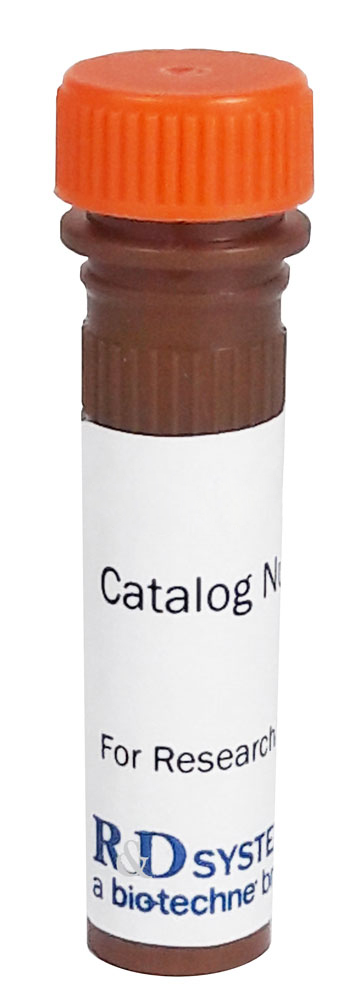Human KIR2DL4/CD158d Alexa Fluor® 700-conjugated Antibody Summary
Accession # Q99706
Applications
Please Note: Optimal dilutions should be determined by each laboratory for each application. General Protocols are available in the Technical Information section on our website.
Reconstitution Calculator
Preparation and Storage
Background: KIR2DL4/CD158d
KIR2DL4 (also known as 2DL4, p49, CD158d, KIR103) is a type I transmembrane protein of the killer cell Ig-like receptor (KIR) family expressed on NK and subsets of gamma δT and memory/effector alpha beta T cells. KIR2DL4 is a unique KIR (1-3); alleles are not clonally restricted but are expressed codominantly (4) in all activated NK cells and constitutively on CD56hi NK cells. KIR members with two Ig-like domains (2D) usually express domains D1 and D2, but KIR2DL4 expresses D0 and D2. Other long-tailed (L) KIR have two cytoplasmic inhibitory signaling domains (ITIM), but KIR2DL4 has one ITIM and also exhibits characteristics of activating KIR (2). An arginine within the transmembrane sequence of KIR2DL4 interacts with the signaling molecule Fc epsilon RI-gamma, while in activating KIR, a transmembrane lysine interacts with DAP12 (1, 5). The KIR2DL4 gene is highly polymorphic. Seven splice variants missing one or more exons have been identified, but it is not clear whether these are expressed. Several of the nine alleles identified encode a frameshift creating a prematurely truncated protein. It is estimated that up to 25% of humans do not express KIR2DL4 capable of reaching the cell surface (1, 7, 10). Human KIR2DL4 is 65-83% amino acid identical to other primates. KIR receptors have no structural orthologs in non-primates, although mouse Ly49 proteins are functional orthologs. Cross-linking of KIR2DL4 induces NK cells to produce IFN-gamma (6, 7); stimulation with IL-2 upregulates cell surface expression on CD56dim cells and allows cytotoxicity (7). Although a role in immune privilege of the fetus has been suggested due to reported recognition of fetal trophoblast HLA-G by KIR2DL4 in the maternal decidua (11), subsequent data have not supported this recognition (1, 9).
- Lanier, L.L. (2005) Annu. Rev. Immunol. 23:225.
- Faure, M. and E.O. Long (2002) J. Immunol. 168:6208.
- Selvakumar, A. et al. (1996) Tissue Antigens 48:285.
- Chan, H-W. et al. (2003) J. Exp. Med. 197:245.
- Kikuchi-Maki, A. et al. (2005) J. Immunol. 174:3859.
- Rajagopalan, S. et al. (2001) J. Immunol. 167:1877.
- Kikuchi-Maki, A. et al. (2003) J. Immunol. 171:3415.
- Gedil, M.A. et al. (2005) Tissue Antigens 65:402.
- Witt, C.S. et al. (2002) Eur. J. Immunol. 32:18.
- Goodridge, J.P. et al. (2003) J. Immunol. 171:1768.
- Ponte, M. et al. (1999) Proc. Natl. Acad. Sci. USA 96:5674.
Product Datasheets
Product Specific Notices
This product is provided under an agreement between Life Technologies Corporation and R&D Systems, Inc, and the manufacture, use, sale or import of this product is subject to one or more US patents and corresponding non-US equivalents, owned by Life Technologies Corporation and its affiliates. The purchase of this product conveys to the buyer the non-transferable right to use the purchased amount of the product and components of the product only in research conducted by the buyer (whether the buyer is an academic or for-profit entity). The sale of this product is expressly conditioned on the buyer not using the product or its components (1) in manufacturing; (2) to provide a service, information, or data to an unaffiliated third party for payment; (3) for therapeutic, diagnostic or prophylactic purposes; (4) to resell, sell, or otherwise transfer this product or its components to any third party, or for any other commercial purpose. Life Technologies Corporation will not assert a claim against the buyer of the infringement of the above patents based on the manufacture, use or sale of a commercial product developed in research by the buyer in which this product or its components was employed, provided that neither this product nor any of its components was used in the manufacture of such product. For information on purchasing a license to this product for purposes other than research, contact Life Technologies Corporation, Cell Analysis Business Unit, Business Development, 29851 Willow Creek Road, Eugene, OR 97402, Tel: (541) 465-8300. Fax: (541) 335-0354.
Citation for Human KIR2DL4/CD158d Alexa Fluor® 700-conjugated Antibody
R&D Systems personnel manually curate a database that contains references using R&D Systems products. The data collected includes not only links to publications in PubMed, but also provides information about sample types, species, and experimental conditions.
1 Citation: Showing 1 - 1
-
Homeostatic Function and Inflammatory Activation of Ileal CD8+ Tissue-Resident T Cells Is Dependent on Mucosal Location
Authors: Lisanne Lutter, Britt Roosenboom, Eelco C. Brand, José J. ter Linde, Bas Oldenburg, Ellen G. van Lochem et al.
Cellular and Molecular Gastroenterology and Hepatology
FAQs
No product specific FAQs exist for this product, however you may
View all Antibody FAQsReviews for Human KIR2DL4/CD158d Alexa Fluor® 700-conjugated Antibody
There are currently no reviews for this product. Be the first to review Human KIR2DL4/CD158d Alexa Fluor® 700-conjugated Antibody and earn rewards!
Have you used Human KIR2DL4/CD158d Alexa Fluor® 700-conjugated Antibody?
Submit a review and receive an Amazon gift card.
$25/€18/£15/$25CAN/¥75 Yuan/¥2500 Yen for a review with an image
$10/€7/£6/$10 CAD/¥70 Yuan/¥1110 Yen for a review without an image

